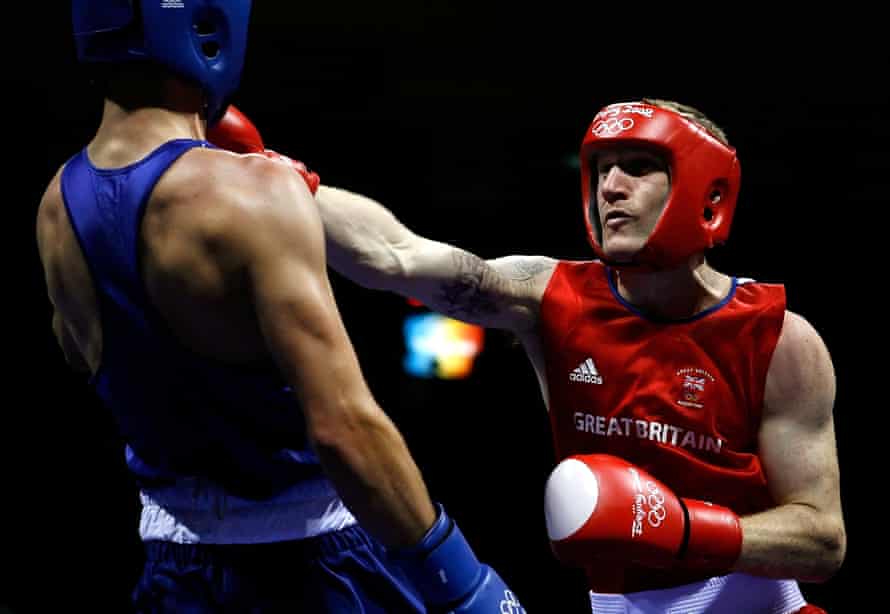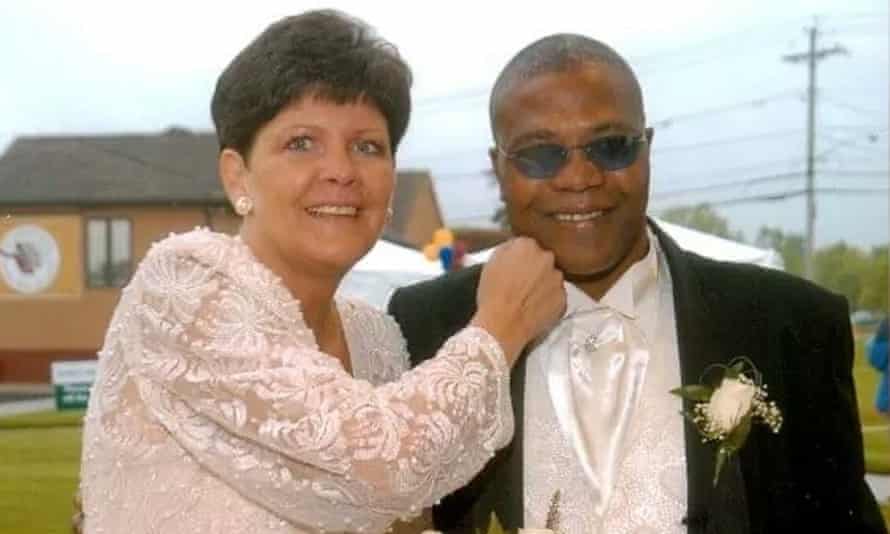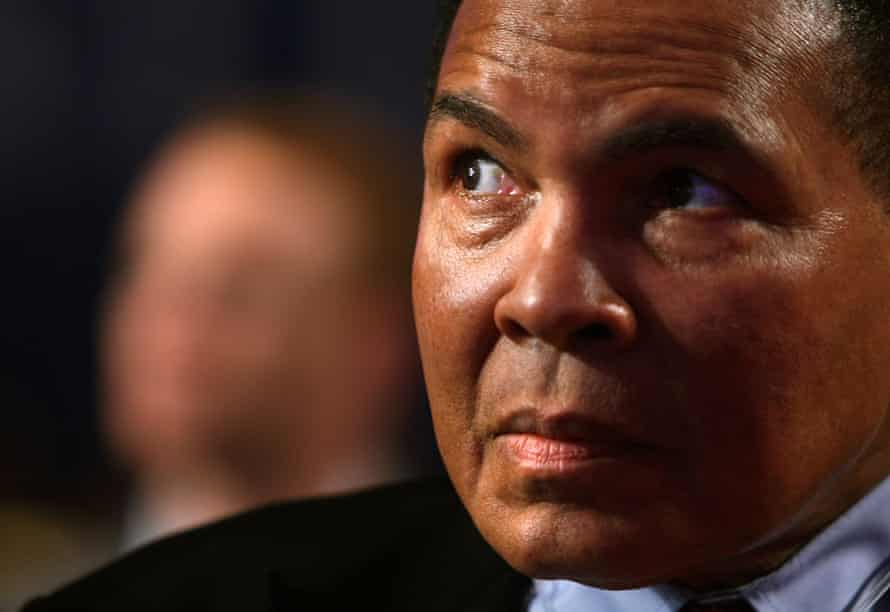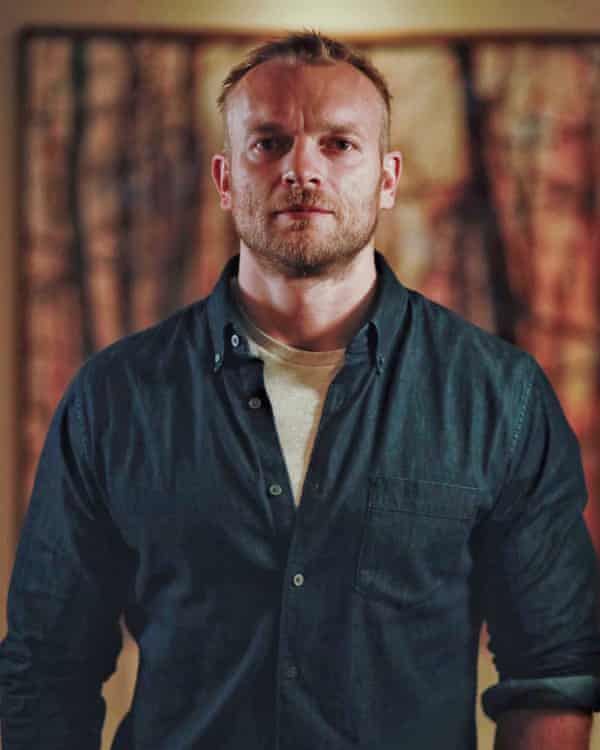Terrible: Baby Gets Punched in the Head During Fight Between 2 Guys!
T he writer, the fighter, the doctor and the widow all look downwards into the darkness and harm of boxing. They understand the previously untold story of brain trauma in the ring and, as they talk to me, their moving testimony underpins a shared conventionalities that modify has to come. There is a measured urgency to their words for they dearest the fighters and they want to offer their knowledge to help make this brutal sport a fiddling safer.
Damage and death have always framed battle. This harsh truth means that, despite the chaos outside the ring, boxing is shockingly real. It tin can maim and fifty-fifty kill but, in a strange paradox, boxing as well makes almost fighters experience more intensely live than anything else.
Tris Dixon has written the book that battle has always needed. Dixon, the quondam editor of Boxing News, at present a freelance author and the host of the Boxing Life Stories podcast, confronts the damage done to fighters with unflinching honesty. It is shattering withal tender as Dixon charts the history and science of CTE (chronic traumatic encephalopathy), a brain condition acquired by repeated blows to the head.
He shows how information technology was called "punch-boozer syndrome" and "dementia pugilistica" as neurologists struggled to explain the slurred speech, memory loss, shakes, violent mood swings, depression and other symptoms. Dixon's volume reads powerfully considering he is such an authority on boxing and he writes near fighters with deep amore and respect.
Dixon also talks to battle widows. The virtually interesting is Frankie Pryor who tells me how she met her husband in rehab 30 years ago. Aaron Pryor, revered in battle every bit The Hawk, was a ii-times light-welterweight world champion who fought professionally from 1976 to 1990. He won 39 of his forty fights, including two unforgettable battles against another legendary boxer, Alexis Argüello, in 1982 and 1983.
Pryor was friends with Muhammad Ali but The Hawk and The Greatest were both irreparably damaged. Battle spares no 1. Pryor died in 2016, aged 60, and his widow explains his deterioration and the salvation boxing once offered.
Tony Jeffries is the fighter. The 36-twelvemonth-old is from Sunderland and he and his family are now "living the dream" in Los Angeles where he runs 2 successful gyms. Jeffries won an Olympic bronze medal in 2008 and he was an unbeaten pro later 10 bouts when, in 2011, his delicate easily forced his retirement. Jeffries hopes he "dodged a bullet" called CTE. He boxed between the ages of ten and 27 and, according to his calculations, was punched in the head "betwixt 40,000 and 50,000 times". Jeffries waits anxiously for the consequences.

Those numbers are described equally "scary" when I share them with Dr Margaret Goodman, a Las Vegas neurologist who worked equally a ringside doc from 1994 to 2005. She tended to fighters in more than 500 professional person bouts but, in campaigning for their condom, was burnt out past battle and so she founded, and is now the president of, Vada – the Voluntary Anti-Doping Association. "Boxing," Goodman notes, "is a cute sickness in and then many means."
The widow, the fighter and the doctor feature in Dixon's book. They recognise its significance, which comforts the writer. "I am worried the anti-boxing brigade might use my argument confronting the sport," Dixon tells me. "Only the direction of the volume is to say: 'We don't talk about information technology but this is what needs to exist washed to mitigate the risks and to make sure these guys have a better life after boxing.' I don't desire a scrapheap of damaged fighters."
He has been immersed in the sport for decades but does Dixon feel fresh hope that boxing might examine the damage information technology causes fighters who generate billions of dollars for wayward governing bodies, promoters and managers? "No – only it's time to discover out who cares. Who wants to look after fighters? If these people want fighters to be OK subsequently boxing then I'm not going to accept the ego to say they must read the book. But I suggest they larn almost CTE, tau protein and links with Alzheimer's, dementia, Parkinson'due south and ALS [amyotrophic lateral sclerosis].
"If they want what's best for the fighters, and then regulate how much sparring they do and take open conversations with boxers as to how they feel after sparring. It's also downward to the fighters to not exist so macho. Fighters and trainers need to know what's going on with their brains."
Dixon, Pryor, Jeffries and Goodman soon list the causes and possible solutions to brain trauma but it is instructive to hear most the book's origins. "Information technology was simply when I read League of Denial nearly the NFL's concussion crisis that I started to slice the puzzle together," Dixon says. "I read about the erratic behaviour of Mike Webster [who won four Super Bowls with the Pittsburgh Steelers in the 1970s]. He fell on hard times and concluded up living in his car.
"I thought: 'This is boxing.' CTE is really dial-drunkard syndrome. It was a big epiphany for me: 'Hang on, the NFL are addressing this merely we practice nothing in battle.' I'd been in boxing 25 years and I didn't know nearly CTE, tau protein and things that should exist a staple. Fireworks went off in my head: 'Wow, these guys worrying well-nigh the NFL could exist worrying well-nigh boxing, which is far more unsafe.' The NFL concussion argue started with the Webster example in 2000. Battle turned its back for nine decades and nosotros oasis't had our Webster moment yet."
The historical sweep of Dixon'south book shows how, in 1928, the American doctor Harrison Martland wrote a paper called Punch Drunk. Information technology was a groundbreaking study but Martland argued wrongly that punch-boozer syndrome merely afflicted mediocre boxers. Damage is a salutary reminder that well-nigh all nifty fighters – from Joe Louis and Sugar Ray Robinson to Muhammad Ali and Aaron Pryor – had their senses obliterated by battle.
Dixon and Frankie Pryor argue that boxing missed a huge opportunity to educate people during Ali's tragic instance. "The old punch-drunk terminology was rarely used with Ali," Dixon says. "Perhaps they thought information technology too cruel a label for a man who gave so much and awed the world with his barbarous elegance. The stigma remains that dial-boozer syndrome happened to guys who aren't very adept. Mayhap Ali was too vain to say: 'Boxing did this to me.'"
Frankie Pryor agrees: "The 1 fighter who could have brought lots of attending to this was Ali. [But] Ali's family chose to say, 'Oh, he has Parkinson'due south, it has nothing to do with battle.' It has everything to exercise with boxing."
Dixon'south volume is compassionate in the visitor of Frankie and Brenda Spinks – whose husband, Leon, shocked a faded Ali in the starting time of their two fights in 1978. Leon Spinks, who fills the final pages of Damage, was a slurred wreck before his decease in February. "At the end," Dixon says, "I wrote that the neurologists were every bit much the heroes to me as the fighters. If I could rewrite that sentence I'd say the wives, women like Frankie and Brenda, are the real heroes. Their strength of graphic symbol is what boxing needs to address the harm. The fighters I've met who don't have these women to look subsequently them, to feed or clothe them, terminate up homeless and suicidal."
F rankie Pryor fills my Zoom screen with warmth and humour – and a little anger at boxing'south failure to talk over the damage information technology did to her husband and most fighters. "I took care of everything," she says of her 30 years with Aaron. "I didn't sympathise the damage was caused solely by boxing until he started showing acrimony. Aaron was so like shooting fish in a barrel-going until then. I started taking him to a neurologist around 1994. At that point we didn't know [it was CTE]. Initially it was just forepart temporal lobe damage but he never stopped going to a neurologist until he died. A neurologist said: 'This is the only Hall of Fame fighter I'll ever work with and we demand more proof to confirm what we believe.'"
Was in that location sufficient proof Pryor had been encephalon-damaged by boxing? "Oh aye. Yous come across that damage in every old fighter – without exception. I noticed all the fighters acting the same when we got together. His wife would go to the restroom and that fighter would get confused. One of us other wives would handle the situation. We educated ourselves about CTE because it's not something you talk about to your regular girlfriends. We had this group – me, Brenda Spinks, Marvin Hagler's wife Kay, Ken Norton'southward wife, Rose."

Amid the mess of battle will their feel of CTE be shared widely? "You said it. Boxing is a mess and that'due south why I have no hope this will ever go solved unless in that location is one central governing body. I'd talk for hours if yous get me started on the crooks in battle. It'southward atrocious and they accept such reward of dedicated fighters who love their sport. Nothing will ever originate from boxing itself."
Pryor believes the just promise is to educate a new generation of fighters and trainers about CTE. Information technology was too tardily for her hubby simply she stresses: "I've no hate for battle because Aaron loved it and so much. It took my husband but his option to box came earlier me. Ane of his nurses said: 'Don't you wish you lot'd never boxed?' He said: 'What do yous mean? No. What would I have done?' Aaron was a fighter. Whenever we went out people always yelled: 'What time is information technology? Hawk Time!' Aaron was born for it and his great achievement was to go this amazing athlete, The Militarist, who came out of a desperately troubled childhood."
She laughs when I enquire if she too called him The Hawk? "Of course. I'd say: 'Even the Hawk has to take out the garbage.' He was The Militarist the day he died."
Tony Jeffries was called "Jaffa" or "The Mighty Mackem" when he boxed. We talk on a beautiful morning in Santa Monica, where he teaches boxing practice to fettle professionals at his Box N Fire Academy. His accent is pure Mackem as he remembers existence punched in the caput as a 10-year-old. "I got the blackness wink. When I was 12 there were times sparring where I would cry considering I'd been hit that hard. Merely I got through it."
Ali spoke of "the black lights" a fighter sees when hit by a concussive blow. "Yeah," Jeffries says, "it'south similar you've closed your eyes for iii seconds then, boom, they're open. 'What happened?' In the European last, when I was xvi, I fought this Greek guy who was knocking everyone out. He hit me so hard my legs went like jelly. I got a standing eight count and won the fight. Twenty minutes after I went on the podium, got the gold medal, and I didn't take a clue where I was. I said: 'Did I win?' That's pure concussion.
"A few years afterward, later I got hit so hard, I was in my room when my telephone rang. 'Sarah? Who is Sarah? Oh, my girlfriend [and now wife].' But yous just think: 'This is boxing.'"
Jeffries calmly tells me how many times he was hit in the head. "I had 106 fights. I averaged four rounds a fight. That'southward 424 rounds. Permit'south say I got hitting to the head an average seven times a round. That's two,968 punches. If I sparred 10 times for each fight and each spar was six rounds, that's six,360 rounds. Seven headshots every round makes 44,520 blows. It could be a little less or a little more. But 40,000 to 50,000 punches landed."
This methodical calculation underpins a central bespeak that could change boxing. There should be a limit on the amount of sparring where fighters have head shots for, as Jeffries admits, "subsequently merely about every spar, equally a pro, I would have a splitting headache." He acknowledges it would exist difficult to regulate sparring so the just solution is for trainers and fighters to educate themselves about the damage it does and restrict most of their training to torso punching.
Jeffries highlights medical prove which proves that punches to the head of a child under 14, when the brain is even so developing, are peculiarly dangerous. "I was punched in the head 4,000 times by the time I was 12. You lot don't have to be a genius to call up that'southward not adept for the brain."

V years ago Jeffries met Dr Charles Bernick who "runs the biggest fighter brain study in the world. They study fighters' brains over a long period. When I first went I was worried. After the exam they said: 'Your brain is average for a 31-year-sometime.' I was like: 'Yes!' They went: 'But yous need to come up back for years because your encephalon could accept been to a higher place average – or it might deteriorate later. They told me I've got a large split in my membrane which attaches the encephalon to the skull. That'southward afterwards existence punched in the caput. It'due south scary.
"If I forget my car keys or slur my words I think: 'Boom, brain damage.' But I'chiliad doing all I can do to help my brain. I haven't drunk booze since 2019. I want to do what I can for my encephalon and then I can exist as good as possible for my kids."
Jeffries emphasises how much he owes the sport for it sparked his booming new career. "Boxing is great. But it has that distressing end and the only way to fix this is by changing boxing civilization."
Dr Goodman agrees and, from a neurological perspective, she believes "information technology's pretty uncomplicated. I would say 99% of brain damage comes from sparring. Too many fighters go into a fight with concussion, or balmy concussive symptoms. So much brain trauma is based on sub-concussive blows. I call back of Terry Norris [a three-times earth champion in the 1990s], a boxer of nifty skill, and a beautiful person, only he idea information technology was meliorate to have punishment, especially to his head, in the gym. We see the damage that did."
Boxing is chaotic, without an international governing torso, only does Goodman believe educating trainers and fighters would adjourn the damage? "I really exercise. Nosotros need to become battle out of the dark ages considering this information is at their fingertips. It amazes me boxing does not aid fighters in this way."
What else should be done to brand such a perilous sport safer? "Fight at the right weight. So many fighters are put in the wrong division and end upwardly cutting weight. If they were in the correct weight course information technology would cease then much damage and prevent eating disorders. They also demand to avoid all operation-enhancing drugs. Even those that are not prohibited are detrimental. Booze, besides, because it can rot a fighter's brain.

"Fighters are so intelligent it's silly for them non to take responsibleness for their wellbeing. They have the knowledge to say no to a fight or sparring. Taking that responsibility is the about important mode we can change boxing."
She points to Floyd Mayweather Jr, the virtually successful and richest boxer of the 21st century. "I worked on his get-go championship fight and he is the quintessential professional. He looked at his Uncle Roger [the old fighter who suffered encephalon damage before his death in March 2020] and understood that staying in shape was vital. Floyd was so smart well-nigh sparring so petty." Mayweather, still, could be spiteful and his care for himself did non always extend to other fighters in the gym. Goodman suggests: "George Foreman is another good instance because he never sparred much either. Even after all those tough fights he's healthy today."
Goodman also believes that doctors should lessen the pressure on fighters past catastrophe bouts before. "What bothers me more than anything is that ringside physicians don't desire to be the one pulling the plug. Fighters are willing to exit on their shields – and if they don't so they get ludicrous abuse. The physician should take the responsibility off the fighter and the corner. Of course information technology's not piece of cake. I've been the brunt of terrible criticism and felt similar I needed to check my brakes before driving home. You develop and so many enemies."
She was so consumed by safeguarding boxers that, before being ringside, she studied their previous bouts for signs of neurological impairment. Goodman was also the ringside doctor when two fighters, Pedro Alcázar and Leavander Johnson, lost their lives. Finally, tuckered and exhausted, she stepped away. Does she ever retrieve boxing should be banned?
"No. We can make it safer. I don't think boxing should be banned – always."
The doctor, the widow, the fighter and the author take witnessed the worst of boxing. Simply they still support its being and its homo qualities of backbone and resilience, skill and intelligence. Goodman sounds uplifted when she remembers working with fighters. "Information technology was such a privilege to examine and talk to fighters who take been among the most famous and brilliant in boxing. Simply to empathise their motivation was inspiring.
"Fighters were the all-time patients I ever had – even if the regulators weren't protecting them enough. I don't want to insult the patients I have now, but sitting with a fighter at the weigh-in, in the corner during a fight and then afterwards was more dramatic, incredible, educational and amazing than anything else. Oh my God, to be with a fighter after a fight? To see the emotion later on winning or losing? It virtually seemed inappropriate to have been privy to that. And then from a medical and a personal standpoint I never had anything I enjoyed more than than boxing. Nosotros know the damage but, oh, the fighters are incredible. Nosotros merely demand to take care of them and help them take ameliorate care of themselves."
Damage: The Untold Story of Brain Trauma in Boxing by Tris Dixon is published by Hamilcar
-
This article was amended on 28 May 2021. A mistyping gave the estimate for punches sustained by Tony Jeffries in 424 rounds as 2,698 instead of ii,968.
Source: https://www.theguardian.com/sport/2021/may/27/time-to-find-out-who-cares-boxing-brain-damage-tris-dixon
0 Response to "Terrible: Baby Gets Punched in the Head During Fight Between 2 Guys!"
Post a Comment